Guide To Search Engine Optimisation (SEO) in 2022 & Beyond
—Hello and welcome to the Clientside Digital Hub, a free training series for digital marketers, marketing managers and company owners looking to inject growth into their businesses using digital. I’m Dean Duffield from A Digital and thank you for joining us.
In this edition we take a fresh look at how you can generate more visitors to your website with Search Engine Optimisation. We’ll take you through what SEO means, why you should include SEO in your digital marketing strategy and what it takes to be successful with SEO in 2022 and beyond.
What is Search Engine Optimisation?
Let’s start with defining exactly what SEO is.
SEO is the process of improving the quality and quantity of visitor traffic to a website from organic search engine results.
- Quality: visitors who are interested in your products or services
- Quantity: more quality visitor traffic is better
- Organic: visitor traffic from search you don't have to pay for
In this example you can see the organic listings highlighted in yellow underneath the blue paid positions. It’s these organic listings that are affected by your SEO efforts.
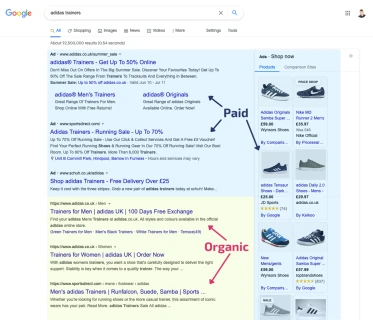
Organic listings sit underneath paid adverts in search results.
Who are the search engines?
There are several search engines used across the world. As of May 2021, Google has a whopping 91% market share, followed by Bing with 3% and Yahoo with a 1.5% market share.
Baidu is China’s most used search engine with 1.7% market share, whilst Yandex is a popular search engine in Russia with 0.92% share. Finally, DuckDuckGo with 0.66% share.
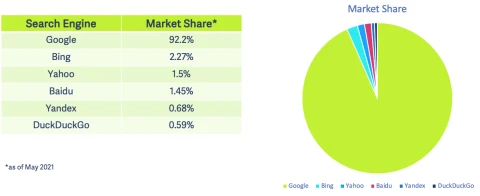
The Google Powerhouse
It’s not difficult to see why Google dominates online search globally, with 3.8 million searches every minute, equating to 228 millions searches per hour and 5.6 billion searches every day.
When we’re looking for something on the internet we have a choice where we start our search, but for most of us that just means ‘Google it’.
Here's some other interesting stats:
- The average person conducts 3-4 Google searches every day
- 60% of Google searches are completed from a mobile device
- 15% of all searches have never been searched for before on Google
So given that most people are using Google, that’s really where the focus of your SEO efforts should be.

Where do you need to rank on Google?
So you want your website to appear on Google, but where exactly?
As high up the rankings as possible.
Only 0.78% of Google searchers click on something from second page. As the popular SEO joke goes... "If you ever need to hide a dead body place it on the second page of Google results" 😀
Not only that...
The top 3 Google results get approximately 75% of all organic clicks so ideally within the top positions too!
So, you certainly want to be want to be ranking on the first page and ideally within the top 3 results which is where most people are clicking.
As the graph below shows, the higher your website’s ranking position and closer you appear to that top number 1 position, the more people will see your listing and are likely to click through to your website. Again, you really want to be aiming within the top 3 positions.
Ranking in lower positions and particularly below position 5, you will attract some visitors to your website but at a much reduced level, which means you may be missing out on the largest share of important visitor traffic within your industry.
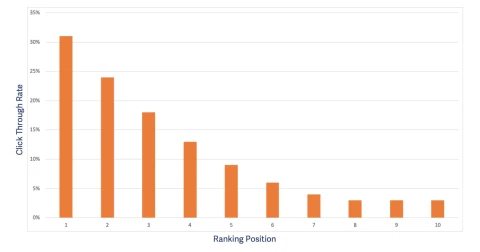
Google click through rate by ranking position.
The business impact of doing SEO
And so, looking at the graph on the left below, the higher your ranking position in search results, the more website traffic you’re likely to generate.
And on the right, the more website traffic you can generate from people interested in your products or services, the more leads, customers and sales you’re likely to acquire.
Essentially, by investing in SEO and appearing high in Google search results can really help you grow your business.
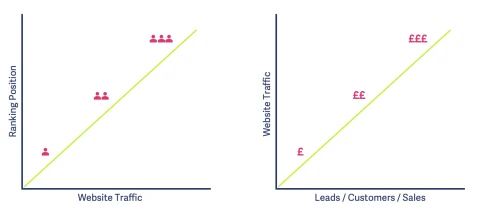
SEO can generate increased sales for your business.
How do you actually get to the top of Google?
To rank well on Google, you need to nurture your brand by building its expertise, authority, and trustworthiness - known as E-A-T
Google wants you to be an expert in your field. They want people with everyday expertise in a particular topic.
E-A-T itself isn’t a ranking factor, but is a set of website quality standards that Google apply when evaluating websites for showing them in search results.
Basically, Google wants to ensure that when people search for something, not only do they get the right search results that best matches their query, but that they also get high quality results, with content created by people who know what they’re talking about, on websites that they can trust.
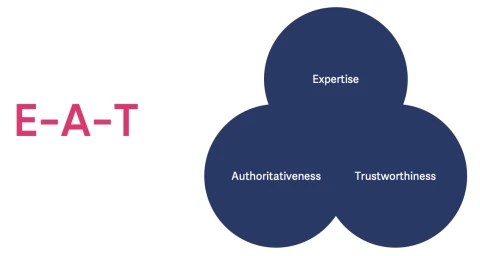
You need to build expertise, authority and trustworthiness.
Search engine optimisation as a deliverable or process can be broken down into 3 areas - technical, content and backlinks.
To rank highly in Google, particularly for popular searches, your website will need to meet a set of criteria for each:
- Your website needs to sit on a solid foundation of technical SEO so that Google can crawl and index your site easily
- Content includes everything on your website such as text, images, videos, blog posts and interactive tools
- To rank highly in Google you need to generate credible backlinks from other places on the internet to your website
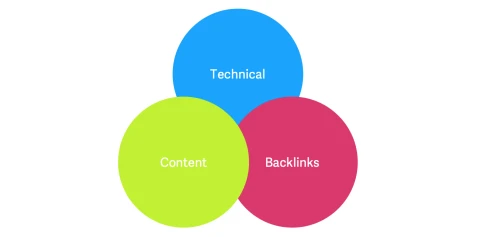
The 3 silos of search engine optimisation.
Google's ranking factors
To break this down here are some of Google’s main ranking factors you need to focus on to be successful with SEO and rank high in search results.
Your website needs to have:
Quality content
Backlinks from other websites
Content that matches the searchers intent
Fast loading pages
Mobile friendly layout
Good domain authority
Keywords included in your pages
Well organised page structure
Secure pages
Great user experience
Google actually has over 200 factors and signals that all combined help to determine where they rank a web page in its search results. Some carry more weighting over others, but let’s continue looking at some of the main ranking factors and what they mean.
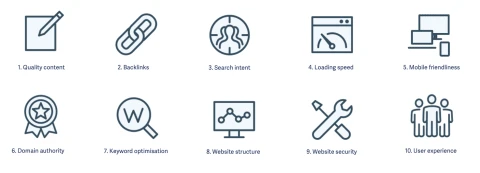
1. High quality content
Without great content, you’re not doing SEO.
To rank high in Google, the single most important thing you need to do is create content that is original, unique and valuable to your readers. Content that answers your reader's questions and is different and better than your competitors.
Use a range of different content such as blog posts, how-to guides, images, videos, case studies and checklists to answer different search queries and to keep readers interested and engaged on your website.
Keep blog posts well organised and structured, using multiple headings to group your content together. Use bullets and lists to simplify your key messages.
Keep your content up to date and fresh, and that has depth and covers topics in detail.
2. Backlinks
Backlinks are inbound links from other websites to yours.
Google sees backlinks as a vote of confidence for your website. If lots of other websites link to your website then Google may see you as the authority of your topic and rank you higher than your competitors in search results.
But for others to link to your website, your content needs to be superior to other similar content on the internet. It needs to stand out above everything else and be interesting enough for others to want to share and link to it.
Keep a look out to form partnerships with other industry experts that might want to link to your content. Create articles or interactive features on your website that draws attention from people who are likely to share it across their social media profiles. Create up-to-the-minute news-worthy content from data sets related to your business, then reach out to relevant resources and news outlets asking if they’re interested in running your story.
There are many opportunities across the internet to gain backlinks. But make sure the link makes sense in that it’s relative to your topic or industry and doesn’t look like you’re adding links to your site for the sake of it. Google much prefers links to happen naturally and gradually over time.
3. Search intent
Search intent is about creating content on your website that matches what people are searching for in Google. It’s about addressing their reasons and motivations behind their search. Do they want to learn something? Do they need help solving a problem? Or are they looking to make a purchase?
When you’ve a good understanding of what you want to say on your website, you then want to decide on the type and format of your content to best address the searcher’s intent.
For example, let’s say you sell guitars online. Someone searches in Google “How to change guitar strings”. At this point they’re not looking to purchase a guitar. They’re clearly looking for something to help guide them through changing the strings on their guitar. This presents a great opportunity to grow your brand and attract future customers to your website by creating a piece of content that helps them solve their problem. In this scenario, a written step-by-step guide accompanied by a video demonstration would be super helpful.
4. Website loading speed
Ensuring your website pages load quickly is important as part of your SEO efforts to improve your Google rankings and grow traffic to your website.
The recommended page load time for websites on both mobile and desktop devices is under 3 seconds. When people land on a web page they expect it to be fully loaded immediately, otherwise they’re likely to leave your site and jump back to Google and on to another website.
Google has announced that Core Web Vitals will be part of its ranking factors starting in 2021, meaning you have to seriously consider optimising your page speed experience to avoid any ranking drop.
Head over to Google Pagespeed Insights to check your website page loading times.
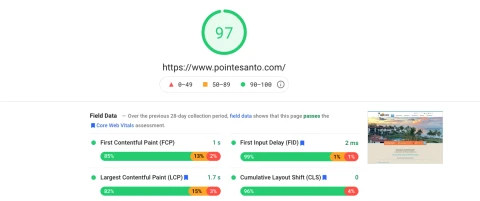
Use Google PageSpeed Insights to see how fast your pages are.
5. Mobile friendliness
It is key that your website is mobile responsive, meaning that your site provides a positive user experience on smartphone devices and tablets as well as on desktop PCs.
Google actually uses your website’s mobile version for indexing and ranking pages when someone is searching in Google whilst on their mobile.
It’s important to keep page layouts and content clear for your users and that they can navigate your website easily when visiting from a mobile device.
Check your website using Google’s mobile-friendly testing tool.
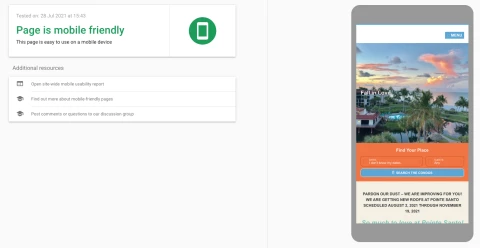
Check your pages are easy to use on a mobile device.
6. Domain authority
A score between 1-100 that shows the level of your website’s expertise about a particular topic, and the ability to rank on search engines.
To boost your domain authority you need to be the expert in your topic, products or services. And how do you become an expert? As we mentioned earlier, you need to create amazing content focussed on your niche and acquire high-quality backlinks from other websites with high domain authority.
The higher your domain authority the higher your chances of ranking above your competitors on Google.
Check your website's domain authority at https://moz.com/domain-analysis and https://ahrefs.com/website-authority-checker
7. Keyword optimisation
Keywords are the search terms people use to look up things on Google.
It’s important your website contains the keywords your audience is searching for to allow Google to rank your website in search results.
There are several places your target keywords need to appear on your web pages including in meta titles and descriptions, image ALT tags, page headings, page URLs and of course your main page copy.
As well as including keywords in your content, Google also looks at other related words associated with a particular topic. For example, if you have a page on your website about surfing, you're likely to naturally include related topics and words such as surfboards, wet suits, surfing techniques, wave intensity, competitions and popular surfing locations.
Firstly, find out which keywords and phrases people in your industry are using. Go to Google and do a few searches related to your business and see what topics and keywords other websites are including in their content. Also look at Google’s ‘related searches’ at the bottom of the search results page.
Start building a list of all the keywords and phrases you want your website to rank in Google for. Group them together and think of different topics for pages and articles on your website. As you build on your content using these keywords, Google will see you as an authoritative voice for your topics and start ranking you higher up in search results.
8. Website structure
People prefer websites that are easy to navigate around, and so does Google. Having a well organised website with related pages and content grouped together makes good sense for your visitors.
Think of the journey you want your visitors to take when they land on your website. If they land on your home page, provide clear links to other sections of your website. If they don’t land on your home page but perhaps a product category page or a blog article - where would you want them to go next? Be sure to direct your users to the next step of their journey with clear links to other pages and content.
Have your web designer work with you to create a website structure and an organised content architecture that makes sense to you, your customers and Google.
Also, be sure to add an XML sitemap to help Google’s crawlers easily find your website and its pages that they can then rank in search results.
9. Website security
Your website’s security is now a key Google ranking signal.
To secure data on your website and show users that you have done so, you’ll need to ensure your website has HTTPS domain distinction by purchasing an SSL certificate.
Having this protection not only gives your visitors peace of mind, but also helps protect from hacking and potentially being blacklisted by Google and other search engines.
10. User experience
Above everything else, providing a positive user experience on your website is paramount if you’re wanting to rank high up in Google’s search results, and they have many signals to measure this including:
Click-through-rate - the percentage of users that click on your website link in search results. Improving your click through rate can boost rankings.
Bounce rate – the percentage of users that click on your site then leave without interacting with other pages. A high bounce isn’t good.
Dwell time – the length of time a visitor stays on your site after coming from Google search results. A higher dwell time is good.
But ultimately, a positive user experience combines all of the different factors mentioned in this presentation… how fast your pages load, how useful and engaging your content is, how clearly your content is laid out, how easy your site is to navigate, and how efficiently your site allows your customers to take action… whether it’s submitting a form, registering an account, signing up for a webinar or making a purchase.
Google prefers websites that provide good user experiences, and will reward those in its search results.
How long does SEO take to show results?
Many business and websites owners rightly ask:
- How long does it take for Google to show my website in search results?
- How long does it take for my website to appear higher up in Google?
- How long does it take for my visitor traffic to increase?
- When can I expect to see more enquiries and sales from Google search?
The reality is, SEO requires a lot of time and effort, particularly when trying to rank for highly competitive keywords and phrases, and in crowded markets. But it can be done.
If you’re considering investing in SEO, it’s always a good idea to set some goals and KPIs so you can measure your progress. Whilst your end goal might be to increase sales through your website, you first need to create pages and content for Google to include in its results, and then work to improve your ranking positions in order to increase visitor traffic over time.
Every website and every industry is different, but in our experience you could expect to see results within 6-12 months, with a measurable increase in visitor traffic.
Ultimately, the key factors that determine how quickly you can be successful with SEO are:
- Your website’s history - are you just starting out or is your website already trusted by Google? Is it ranking already
- Your competition - how many other websites are competing for the same keywords and phrases? How busy is it in your space
- Your resources - who will work on your website, do you have SEO skills within your business, how much time can you allocate to SEO, and what kind of budget do you have to invest in SEO over the next few years and beyond?
It’s also important to mention that SEO can’t really be half in half out if you’re really wanting to compete at the top. Yes your website will naturally rank in Google without having fulfilled every single requirement, but it’s the attention to detail that’ll get your site ranking higher and generating more visitor traffic.
In most cases SEOs need four months to a year to help your business first implement improvements and then see potential benefit.
Maile Ohye, Google
Where do you start with SEO?
You may be planning a new website or a re-development of your existing site. Either way, it’s always best to lay some solid technical SEO foundations that will enable your site to stand the best chance of ranking in Google once you start creating content.
Then, as you’re adding fresh new content across your site, you’ll want to be sharing it in your social posts and email newsletters with links back to pages on your site.
You’ll also want to be promoting your best content pieces out to wider regional and national outlets and other high authority sites that may publish your story or reference you in their own articles where there’s a relatable topic between the two.
In reality, there’s no real beginning and end to each of these and all need to be worked on simultaneously and continuously for long-term sustainable success.
That’s SEO in a nutshell. It’s an ever ongoing process of creation and optimisation to outclass your competitors.
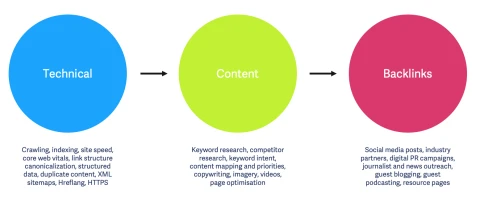
Examples of organic traffic growth from SEO
Here are two examples of how visitor traffic can grow over time when you include SEO in your digital marketing strategy.
The graph below shows organic search traffic following a new B2B website launch. As well as the site’s main pages appearing in Google search rankings, the business also invested in posting regular blog content and backlink campaigns as a way to increase their visibility in Google search and reach more potential new customers.

This graph shows an eCommerce website that was attracting a slowly increasing level of organic search traffic and sales. The business owners wanted to take a larger share of their market at a faster rate, so invested in SEO and digital PR campaigns to boost Google rankings and organic search traffic as quickly as possible. Organic traffic rose by 70%, sales revenue by 60%.

Tools and software for SEO
There are many tools out there to help you research, manage and measure your SEO efforts, and we’ve listed a few of the main players here:
Keyword Research
- Google Search Console
- Google Keyword Planner
- Google Ads
- Google Suggested Searches
- YouTube Autocomplete
- Amazon Autocomplete
Content Topic Research
- Google Trends
- Google ‘People Also Ask’
- Answer The Public
- SparkToro
Technical SEO Tools
- Screaming Frog
- Sitebulb
- Google Page Speed Insights
- GTMetrix Page Speed
- Google Mobile Friendly Test
All-in-One SEO Tools
- Ahrefs
- SEMrush
- Moz
- SE Ranking
The future of SEO: 2022 and beyond
As we reach the end of this session, let’s look at some predictions we think might come into play for SEO over the next few years. Sure, the basic principles of a well-optimised website with quality content is unlikely to change, but Google are constantly updating their ranking algorithm in order to improve search results and deliver the best and most up-to-date content for people.
Better ranking signals - such as Google’s Core Web Vitals which will use a range of metrics to measure page experience such as load time, interactivity and usability. Websites that offer a better all-round experience for their visitors are likely to be rewarded with higher rankings in Google.
More contextual web pages focussed on user search intent - in other words better matching of web pages and content that more accurately addresses the intentions of the searcher in Google
More visual content ranking in Google search results - such as videos, audio clips and images. So it’s important to consider creating different types of content for different purposes.
More integrated with other digital channels - such as social media, paid media and advertising, PR and even offline campaigns. All working together to help boost the visibility of your website in Google
And finally...
Focus on building your brand to get people searching for your company in Google - get involved in blogging, create educational videos, launch a podcast, exhibit and speak at conferences, push your PR activity and if you’ve time, publish a book to really show who’s the boss in your industry and business communities. The more people know you and search for you directly in Google, the more Google is likely to rank you higher than your competitors for other searches related to your products and services.
And that concludes this session. We hope you’ve learned something about search engine optimisation today and why it’s important to include SEO in your digital marketing strategy.
If you’d like to learn more about digital marketing, head over to The Clientside Podcast to hear discussions on digital transformation, lead generation, customer journeys and branding. Also available on Spotify, Apple, Google and many other podcast outlets.
Benchmark your digital performance
Do you want to turn your online presence into a powerful marketing machine for your business? To make it happen, you must understand where you are now. You need to benchmark your current performance before you can identify the gaps between where you are and where you want to be.
Complete our Digital Capability Scorecard and get a FREE personalised report to help you get started.
Get My Free Report


